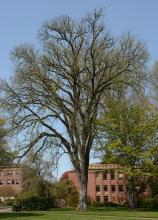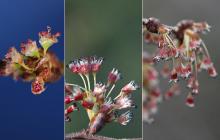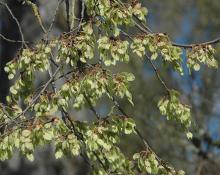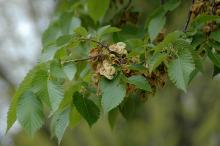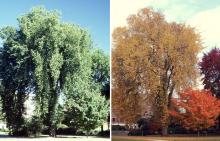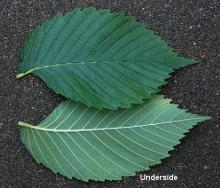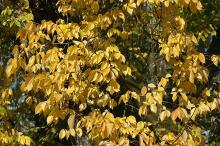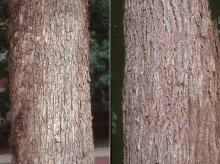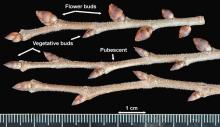Ulmus americana
Common name:
American Elm
Pronunciation:
UL-mus a-mer-i-KA-na
Family:
Ulmaceae
Genus:
Type:
Broadleaf
Native to (or naturalized in) Oregon:
No
- Broadleaf deciduous tree, to over 75 ft (23 m), vase, arching branches (most common form), a spreading form is also seen. Young shoots pubescent at first. Leaves alternate, simple, 7.5-15 cm, ovate-oblong, unequal at base, doubly serrate (toothed), glossy dark green above, 13-18 parallel veins from midvein to the teeth. Flowers perfect, in groups of 3-4, the anthers are bright red, the ovary and styles are light green, and the calyx is green tinged with red above the middle; they appear in spring before the leaves. Fruit rounded, disc-like samara, about 12 mm long, greenish sometime with a reddish tinge, maturing in early summer.
- Sun, prefers rich, moist, soils but grows under a variety of conditions.
-
Once extensively used as a street and lawn tree. Dutch elm disease, which is caused by the fungus Ophiostoma novo-ulmi through its transmission by the elm bark beetle, has changed that. Although no longer common in eastern North America, there are several hundred American elms in Corvallis, most on the Oregon State campus. Newer selections of Ulmus americana show good to excellent resistance to Dutch elm disease and are recommended for planting. These include the following: 'Jefferson', 'New Harmony', Prairie Expedition®, 'Princeton' , and 'Valley Forge'. Many hybrid elms are also resistant to Dutch elm disease.
The term "Dutch" in the name of the disease is a reference to plant pathologists in the Netherlands who did much early work on the disease.
- Hardy to USDA Zone 2 Native from Newfoundland to Florida, west to the Rocky Mountains.
- Hundreds to thousands of Evening Grosbeaks, which are a stout short-tailed finch, briefly visit the Oregon State campus nearly every spring, usually in April. The peak in the population seems to coincide with the maturation of the fruit (seeds) of the many elms on the campus. It appears that the birds prefer the seeds of the American Elm in comparison to the larger seeds of the Dutch elms (Ulmus x hollandica) near Community Hall and those making up the Elm Walk between 15th St. and 11th St.
- Oregon State Univ. campus: tall, arching specimen on the northwest corner of the Valley Library quad, lower spreading form directly west of library, and an intermediate form between these two. There are several on the perimeter of the MU Quad.
Click image to enlarge


